英语修辞与写作修改版
修辞描写英文作文
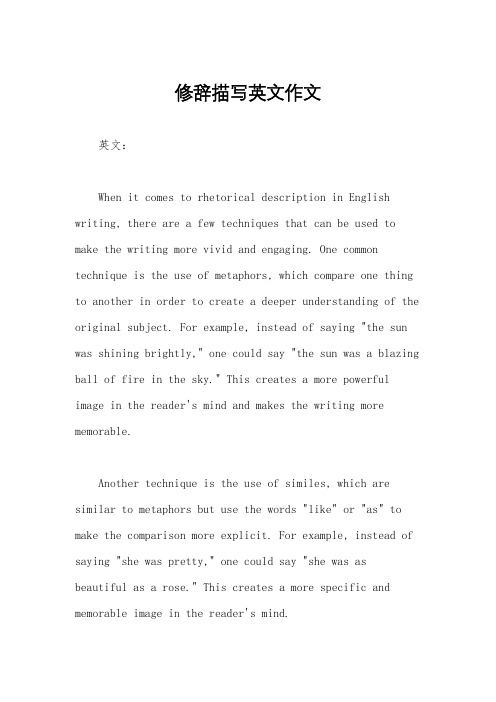
修辞描写英文作文英文:When it comes to rhetorical description in English writing, there are a few techniques that can be used to make the writing more vivid and engaging. One common technique is the use of metaphors, which compare one thing to another in order to create a deeper understanding of the original subject. For example, instead of saying "the sun was shining brightly," one could say "the sun was a blazing ball of fire in the sky." This creates a more powerful image in the reader's mind and makes the writing more memorable.Another technique is the use of similes, which are similar to metaphors but use the words "like" or "as" to make the comparison more explicit. For example, instead of saying "she was pretty," one could say "she was asbeautiful as a rose." This creates a more specific and memorable image in the reader's mind.Personification is another technique that can be used to make writing more engaging. This involves giving human qualities to non-human objects or concepts. For example, instead of saying "the wind was blowing," one could say "the wind howled like a wounded animal." This creates a more vivid and emotional image in the reader's mind.Finally, hyperbole can be used to create a more dramatic effect in writing. This involves exaggerating a statement for emphasis. For example, instead of saying "the car was fast," one could say "the car was so fast it felt like we were flying." This creates a more exciting and memorable image in the reader's mind.中文:在英文写作中,修辞描写是一种常用的技巧,可以使文章更加生动有趣。
英语修辞与写作

第一章明喻、暗喻、换喻、提喻第一节明喻1.1.1 明喻(Simile)的定义The definition of simile-A simile is a figure of speech involving the comparison of one thing with another thing of a different kind by using the words:as,like,as…as,etc.Another definition:A figure of speech in which one thing is likened to another,in such a way as to clarify and enhance an image.It is an explicit comparison(as opposed to the metaphor where the comparison is implicit)recognizable by the use of the word“like”or“as”.有学者认为,“一事物”可称为“本体”,而“另一事物”最好称为“喻体”。
请看例句:New China is like a red sun rising in the east.(本体)(比喻词)(喻体)从例句结构上看,明喻包括“本体”(subject or tenor)和“喻体”(reference or vehicle)。
本体指被比喻的对象,喻体指用来做比喻的对象,比喻词用在本体和喻体之间起连接介绍作用。
从词源上讲,simile源于拉丁词similis,其意义相当于英语介词like(像)。
弄明白了本体、喻体和比喻词,对于理解和掌握明喻是大有裨益的。
1.1.2 明喻的例解1.1.2.1 用like或as引导1.My heart is like a singing bird.(C.G Rossetti:A Birthday)我的心如小鸟在歌唱。
英汉写作修辞对比(第二版)

英汉写作修辞对比(第二版)作英文写作中的修辞技巧通常比中文写作中的要具有更多的优势。
通常来说,中文写作采用的是简单、直接、平凡的语言表达,而英文写作则要求更复杂、多变且富有故事性的语言表达;从写作字迹看,英文拥有更多的修辞手段,可以形象地表达作者的思想和观点,并把自己的内容表达得更加清楚简洁;此外,英文写作还有其正式性和文学性的特质,而中文写作则朴素地列出事实。
另外,尽管两种语言都有共同的修辞手段,比如比喻、排比,但是英文运用修辞技巧的方式更多,更有深度。
首先,英文写作有更精确的修辞。
在英语思维角度来看,英文写作可以更准确地表达自己的观点,通过把修辞手段灵活地运用,比如拟人、比喻、排比、押韵等;并且,在英文写作句法上,它可以灵活使用复句、定语从句、名词性从句等,以此可以把文字文字写得更活跃。
例如:He knew that success would not come overnight, but rather with patience, dedication, and hard work.其次,英文写作重用修辞的方式远与中文相比,英文的句子内部更加精妙,更有深度与张力。
最典型的比喻词汇,如“银色的月光”、“芳香的花儿”、“清澈的湖水”等等,可以让英文的写作雅致、深邃,也能丰富表达的色彩,让读者有另一种更深刻的沉浸体验。
例如:The night was so dark that the stars seemed to glow like fireflies in the sky, and the air was fragrant with the smell of the flowers in the garden.英文写作中拟人手法是人们比较熟悉的一种修辞手段,可以比喻事物,使文章变得活泼、生动。
它可以帮助写作者把让读者更容易把握要点,更好地理解文字内容,或让文字变得更有诗意。
例如:The moon smiled down on the valley, its gentle light illuminating the winding paths like a beacon.最后,从写作形式来看,英文写作更加富有张力和文学气息,写出来的内容更有一定的文采,可激发读者不一样的思想感受。
修辞手法英文作文
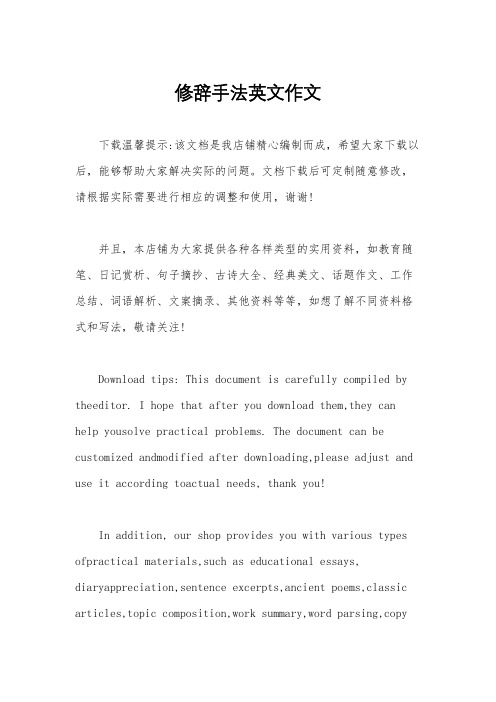
修辞手法英文作文下载温馨提示:该文档是我店铺精心编制而成,希望大家下载以后,能够帮助大家解决实际的问题。
文档下载后可定制随意修改,请根据实际需要进行相应的调整和使用,谢谢!并且,本店铺为大家提供各种各样类型的实用资料,如教育随笔、日记赏析、句子摘抄、古诗大全、经典美文、话题作文、工作总结、词语解析、文案摘录、其他资料等等,如想了解不同资料格式和写法,敬请关注!Download tips: This document is carefully compiled by theeditor. I hope that after you download them,they can help yousolve practical problems. The document can be customized andmodified after downloading,please adjust and use it according toactual needs, thank you!In addition, our shop provides you with various types ofpractical materials,such as educational essays, diaryappreciation,sentence excerpts,ancient poems,classic articles,topic composition,work summary,word parsing,copyexcerpts,other materials and so on,want to know different data formats andwriting methods,please pay attention!Paragraph 1: She's like a shining star in the night sky, so bright and beautiful. Her smile can light up a whole room.Paragraph 2: The wind howled like a wild animal, making a creepy noise. The trees swayed back and forth as if they were dancing.Paragraph 3: His words were sharp as a knife, cutting deep into my heart. But I still stood there, strong like a rock.Paragraph 4: The city was a jungle of concrete and steel, full of life and chaos. People were running around like ants.Paragraph 5: The music was a magic carpet that took meto another world. I could feel the rhythm pulsing throughmy veins.。
English Rhetoric and Writing 英语修辞与写作
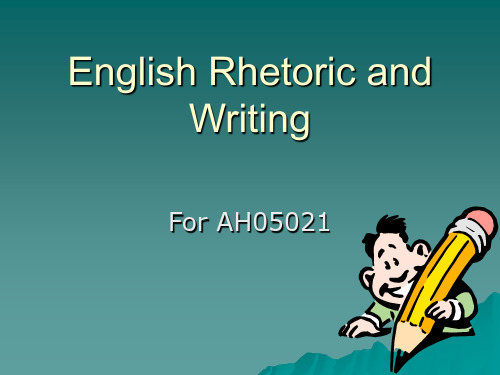
Unit II. Making correct and effective sentences
Language
words. Correct use of sentence is essential for fluent and idiomatic use of English Imitation, accumulation and creation are the three steps to learn any language.
Drills for Summary Ex1,2,3 at page 66-67
IV-1. Write a summary of any in Exercise 4 ( pp66-67 )
Unit V Composing Essays
Type
of writing Narration Exposition Description Argumentation
starts from sentences, not
Drills
for sentences Ex3 at page 37-38. II. Improve the following
sentences:
1.
It snowed heavily at 8 o’clock. 2. The earthquake only damaged a few houses. 3. Shakespeare was one of the greatest dramatists. 4. Mary called Beth everyday when she was in hospital. 5. What one knows is more important than the wealth one has.
超实用高考英语复习读后续写:修辞改装法(原卷版)

读后续写技能训:修辞改装法(原卷版)距离高考还有一段时间,不少有经验的老师都会提醒考生,愈是临近高考,能否咬紧牙关、学会自我调节,态度是否主动积极,安排是否科学合理,能不能保持良好的心态、以饱满的情绪迎接挑战,其效果往往大不一样。
以下是本人从事10多年教学经验总结出的以下学习资料,希望可以帮助大家提高答题的正确率,希望对你有所帮助,有志者事竟成!养成良好的答题习惯,是决定高考英语成败的决定性因素之一。
做题前,要认真阅读题目要求、题干和选项,并对答案内容作出合理预测;答题时,切忌跟着感觉走,最好按照题目序号来做,不会的或存在疑问的,要做好标记,要善于发现,找到题目的题眼所在,规范答题,书写工整;答题完毕时,要认真检查,查漏补缺,纠正错误。
总之,在最后的复习阶段,学生们不要加大练习量。
在这个时候,学生要尽快找到适合自己的答题方式,最重要的是以平常心去面对考试。
英语最后的复习要树立信心,考试的时候遇到难题要想“别人也难”,遇到容易的则要想“细心审题”。
越到最后,考生越要回归基础,单词最好再梳理一遍,这样有利于提高阅读理解的效率。
另附高考复习方法和考前30天冲刺复习方法。
目录Part 1修辞改装法 (2)第一种修辞:比喻 (2)第二种修辞:拟人 (7)第三种修辞:夸张 (10)其他修辞法: (11)Part 2 翻译练习 (17)(第一组) (17)(第二组) (18)(第三组) (18)(第四组) (18)(第五组) (19)(第六组) (19)Part 3 综合演练【模拟题】 (20)1.读后续写模拟专练 (20)2.(2022.湖南.一模) (22)3.(2022.辽宁大连.模拟预测) (23)Part 1修辞改装法今天我要分享的主题是:如何用三种修辞手法来升级我们的句子。
适当的修辞可以让我们的句子增光添彩。
试着比较一下,下面两个句子:第1个句子:Jenny was very happy. (Jenny很开心。
英语作文使用修辞手法的范文
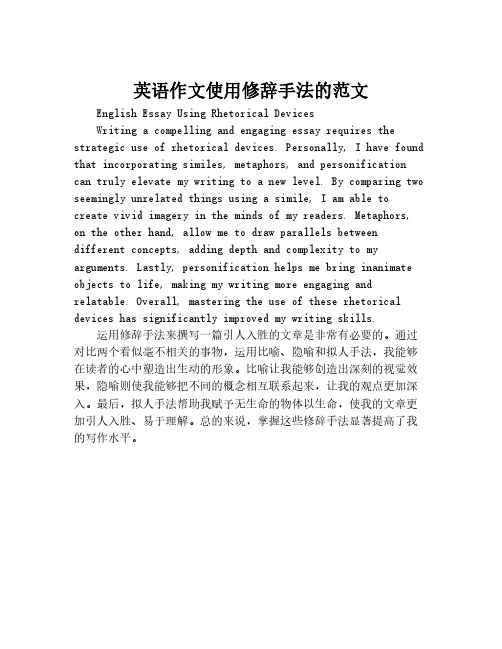
英语作文使用修辞手法的范文English Essay Using Rhetorical DevicesWriting a compelling and engaging essay requires the strategic use of rhetorical devices.Personally,I have found that incorporating similes,metaphors,and personification can truly elevate my writing to a new level.By comparing two seemingly unrelated things using a simile,I am able to create vivid imagery in the minds of my readers.Metaphors, on the other hand,allow me to draw parallels between different concepts,adding depth and complexity to my stly,personification helps me bring inanimate objects to life,making my writing more engaging and relatable.Overall,mastering the use of these rhetorical devices has significantly improved my writing skills.运用修辞手法来撰写一篇引人入胜的文章是非常有必要的。
通过对比两个看似毫不相关的事物,运用比喻、隐喻和拟人手法,我能够在读者的心中塑造出生动的形象。
比喻让我能够创造出深刻的视觉效果,隐喻则使我能够把不同的概念相互联系起来,让我的观点更加深入。
英语写作与修辞艺术
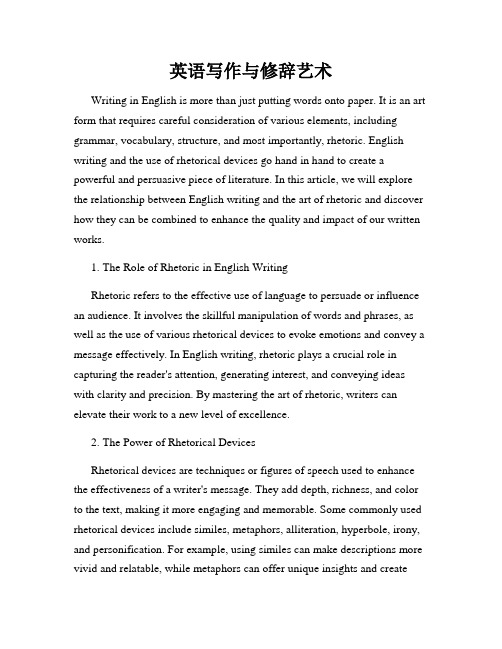
英语写作与修辞艺术Writing in English is more than just putting words onto paper. It is an art form that requires careful consideration of various elements, including grammar, vocabulary, structure, and most importantly, rhetoric. English writing and the use of rhetorical devices go hand in hand to create a powerful and persuasive piece of literature. In this article, we will explore the relationship between English writing and the art of rhetoric and discover how they can be combined to enhance the quality and impact of our written works.1. The Role of Rhetoric in English WritingRhetoric refers to the effective use of language to persuade or influence an audience. It involves the skillful manipulation of words and phrases, as well as the use of various rhetorical devices to evoke emotions and convey a message effectively. In English writing, rhetoric plays a crucial role in capturing the reader's attention, generating interest, and conveying ideas with clarity and precision. By mastering the art of rhetoric, writers can elevate their work to a new level of excellence.2. The Power of Rhetorical DevicesRhetorical devices are techniques or figures of speech used to enhance the effectiveness of a writer's message. They add depth, richness, and color to the text, making it more engaging and memorable. Some commonly used rhetorical devices include similes, metaphors, alliteration, hyperbole, irony, and personification. For example, using similes can make descriptions more vivid and relatable, while metaphors can offer unique insights and createpowerful connections between seemingly unrelated concepts. Overall, the strategic use of rhetorical devices can captivate readers and leave a lasting impression.3. Enhancing Persuasion through RhetoricPersuasion is a fundamental aspect of effective writing, and rhetoric serves as a valuable tool in achieving this goal. Through the use of persuasive language and rhetorical devices, writers can appeal to the emotions, logic, and values of their readers, making their arguments more compelling and convincing. By structuring their arguments in a logical and coherent manner and using rhetoric to support their claims, writers can increase their credibility and influence the opinions of their audience. As a result, the art of rhetoric empowers writers to present their ideas persuasively and elicit desired responses from their readers.4. Developing a Rhetorical Writing StyleTo incorporate rhetoric into their writing, authors must first develop a rhetorical writing style. This involves understanding the various rhetorical devices and practicing their application in different contexts. Writers should strive to create unique and impactful sentences, carefully choosing words, phrases, and rhetorical devices that enhance the overall effectiveness of their message. Additionally, they should pay attention to the organization and flow of their writing, ensuring that their ideas are presented in a coherent and engaging manner. By honing their rhetorical writing style, authors can elevate the quality of their work and leave a lasting impression on their readers.5. Mastering the Art of English Writing and RhetoricMastering the art of English writing and rhetoric is an ongoing process that requires both study and practice. It involves conscious efforts to refine one's language skills, broaden vocabulary, and develop an understanding of various rhetorical techniques. Additionally, reading extensively and analyzing the works of skilled writers can offer valuable insights into the art of rhetoric and inspire new approaches to writing. By continuously honing their skills and experimenting with different rhetorical devices, writers can unlock the true power of English writing and create compelling and impactful pieces of literature.In conclusion, English writing and the art of rhetoric are inseparable. The careful use of rhetorical devices can enhance the effectiveness and persuasiveness of written works, captivating readers and leaving a lasting impact. By developing a rhetorical writing style and continuously refining their skills, writers can harness the power of rhetoric and elevate the quality of their English writing. So, let us embrace the art of rhetoric and unleash the full potential of our words on the page.。
高中英语写作中的修辞手法与表达技巧

高中英语写作中的修辞手法与表达技巧在高中英语写作中,修辞手法和表达技巧是提高文章质量和表达能力的关键因素。
通过巧妙地运用修辞手法,可以使文章更加生动、有趣,同时也能够提升文章的说服力和表达能力。
本文将探讨几种常见的修辞手法和表达技巧,并分析它们在写作中的应用。
首先,比喻是一种常见的修辞手法,它通过将两个不同的事物进行类比,来突出某种特定的意义或形象。
比喻可以使文章更加生动形象,增强读者的感受力。
例如,当我们想要形容一个人非常聪明时,可以使用比喻来表达:“他的头脑像一台高速运转的计算机,能够迅速解决各种难题。
”这样的比喻使读者更容易理解作者的观点,并产生共鸣。
其次,排比是一种修辞手法,通过连续使用相同的句式或结构,来强调一系列相似或对比的事物。
排比可以增强文章的节奏感和表现力,使文章更加有力量和感染力。
例如,“勤劳、智慧、坚持,这些是成功的关键。
努力、奋斗、拼搏,这些是实现梦想的途径。
”这样的排比使文章更加有说服力,读者也更容易接受作者的观点。
此外,修辞问句也是一种常见的修辞手法,通过提出一个或多个问题,来引起读者的思考和注意。
修辞问句可以激发读者的兴趣,使文章更加引人入胜。
例如,“你曾经想过,为什么有些人成功而有些人失败?是机遇?是努力?还是其他原因?”这样的修辞问句可以吸引读者的注意力,引发他们对文章主题的思考。
此外,恰当的比较和对比也是一种有效的表达技巧。
通过比较和对比不同的事物或观点,可以使文章更加丰富多样,增强文章的说服力。
例如,当我们想要表达一个观点时,可以通过比较和对比来支持我们的观点。
例如,“与其沉迷于虚拟世界,不如投入现实生活中的各种活动。
虚拟世界只是一时的快乐,而现实生活才是真正的幸福。
”这样的比较和对比可以使读者更加深刻地理解我们的观点,并产生共鸣。
最后,运用恰当的修辞手法和表达技巧需要不断的练习和积累。
通过阅读优秀的英语作品,我们可以学习到各种不同的修辞手法和表达技巧,并将其运用到自己的写作中。
英语写作修辞手法
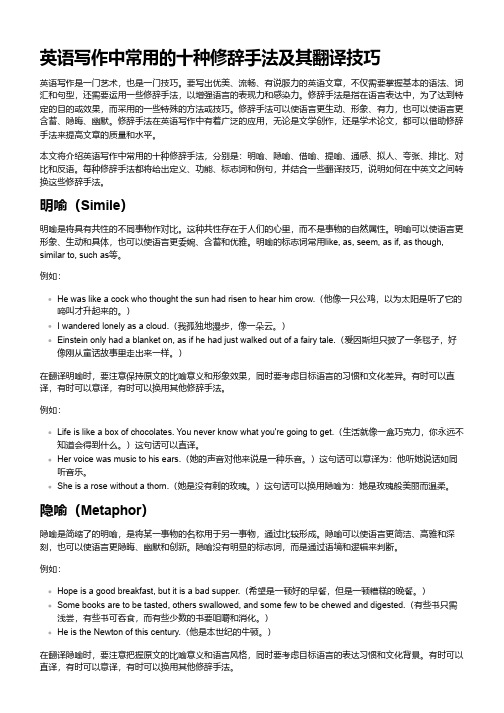
英语写作中常用的十种修辞手法及其翻译技巧英语写作是一门艺术,也是一门技巧。
要写出优美、流畅、有说服力的英语文章,不仅需要掌握基本的语法、词汇和句型,还需要运用一些修辞手法,以增强语言的表现力和感染力。
修辞手法是指在语言表达中,为了达到特定的目的或效果,而采用的一些特殊的方法或技巧。
修辞手法可以使语言更生动、形象、有力,也可以使语言更含蓄、隐晦、幽默。
修辞手法在英语写作中有着广泛的应用,无论是文学创作,还是学术论文,都可以借助修辞手法来提高文章的质量和水平。
本文将介绍英语写作中常用的十种修辞手法,分别是:明喻、隐喻、借喻、提喻、通感、拟人、夸张、排比、对比和反语。
每种修辞手法都将给出定义、功能、标志词和例句,并结合一些翻译技巧,说明如何在中英文之间转换这些修辞手法。
明喻(Simile)明喻是将具有共性的不同事物作对比。
这种共性存在于人们的心里,而不是事物的自然属性。
明喻可以使语言更形象、生动和具体,也可以使语言更委婉、含蓄和优雅。
明喻的标志词常用like, as, seem, as if, as though, similar to, such as等。
例如:He was like a cock who thought the sun had risen to hear him crow.(他像一只公鸡,以为太阳是听了它的啼叫才升起来的。
)I wandered lonely as a cloud.(我孤独地漫步,像一朵云。
)Einstein only had a blanket on, as if he had just walked out of a fairy tale.(爱因斯坦只披了一条毯子,好像刚从童话故事里走出来一样。
)在翻译明喻时,要注意保持原文的比喻意义和形象效果,同时要考虑目标语言的习惯和文化差异。
有时可以直译,有时可以意译,有时可以换用其他修辞手法。
例如:Life is like a box of chocolates. You never know what you're going to get.(生活就像一盒巧克力,你永远不知道会得到什么。
英语修辞与写作修改版

二、各种词语的修辞作用(一)古词语(Archaic)“On my life,” said Quentin, “Y ou are under some delusion——I know nothing of Saint Paul.”“Nay, we question you not,” said the burgher: “although hark ye——I say, hark in your ear——my name is Pavilion.“And what is my business with that, Seignior Pavilion?” said Quentin.“Nay, nothing——only methinks might satisfy you that I am trustworthy.”(“说句天地良心的话,”奎廷说,“你是有些误会——我根本不熟悉圣.保罗。
”“不,我们没有询问你,”那个市民说:“你听着,喂,你用耳朵听着——我的名字是巴维伦”。
“可是那与我有什么相干?巴维伦先生。
”奎廷说。
“不,不相干——只是我想它应该可以使你满足了,我是可以信赖的。
”)“Prithee, do me so much favour, as to inquire after my astrologer, Martinus Galeotti, and send him hither to presently.”“I will, without fail, my liege,” answered the jester,” and I wot well I shall find him at Dopplethur‟s.”(“请你给我帮个忙,问候一下我的占星家马替勒斯.加里奥梯,同时叫他马上到我这儿来。
”“皇上,一定做到,”小丑回答道,“我知道我在多波舍家一定能找到他。
”)I do verily believe I could count on the exceptions on the fingers of my two hands.(我确实相信,我可以掐着两只手的指头算出这些例外。
四种修辞英语作文模板

四种修辞英语作文模板模板一,比喻修辞英语作文。
Title: The Power of Metaphor in Everyday Language。
Metaphors are a powerful tool in the English language, allowing us to convey complex ideas and emotions in a simple and relatable way. Just as a painter uses different colors to create a masterpiece, a writer uses metaphors to paint vivid pictures in the minds of their readers.One of the most common metaphors used in everyday language is "time is money." This simple phrase encapsulates the idea that time is a valuable resource that should be spent wisely. By comparing time to money, we can easily understand the importance of using our time effectively and not wasting it on unimportant things.Another powerful metaphor is "love is a battlefield." This comparison highlights the emotional turmoil and conflict that can arise in relationships, making it easier for us to understand the complexities of love and the challenges it can bring.Metaphors are not only used in literature and poetry, but also in everyday conversation. When we say that someone has a "heart of gold," we are using a metaphor to describe their kind and generous nature. Similarly, when we say that a difficult task is "a mountain to climb," we are using a metaphor to convey the challenges and obstacles we may face.In conclusion, metaphors are a valuable tool in the English language, allowing us to express complex ideas in a simple and relatable way. By using metaphors, we can paint vivid pictures in the minds of our readers and make our language more engaging and expressive.模板二,排比修辞英语作文。
英语写作中的修辞手法与修辞技巧
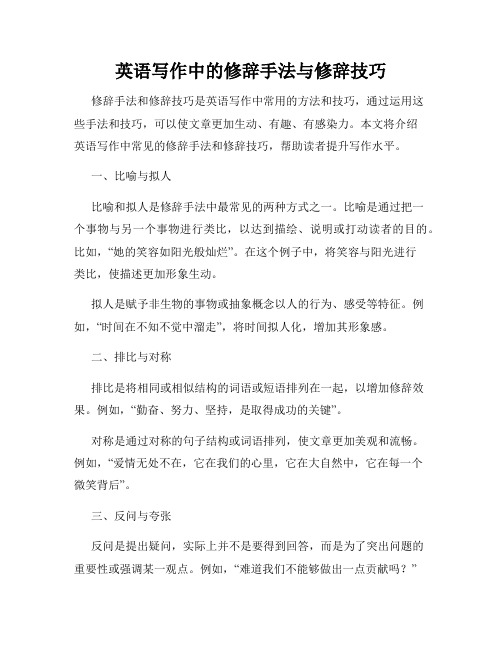
英语写作中的修辞手法与修辞技巧修辞手法和修辞技巧是英语写作中常用的方法和技巧,通过运用这些手法和技巧,可以使文章更加生动、有趣、有感染力。
本文将介绍英语写作中常见的修辞手法和修辞技巧,帮助读者提升写作水平。
一、比喻与拟人比喻和拟人是修辞手法中最常见的两种方式之一。
比喻是通过把一个事物与另一个事物进行类比,以达到描绘、说明或打动读者的目的。
比如,“她的笑容如阳光般灿烂”。
在这个例子中,将笑容与阳光进行类比,使描述更加形象生动。
拟人是赋予非生物的事物或抽象概念以人的行为、感受等特征。
例如,“时间在不知不觉中溜走”,将时间拟人化,增加其形象感。
二、排比与对称排比是将相同或相似结构的词语或短语排列在一起,以增加修辞效果。
例如,“勤奋、努力、坚持,是取得成功的关键”。
对称是通过对称的句子结构或词语排列,使文章更加美观和流畅。
例如,“爱情无处不在,它在我们的心里,它在大自然中,它在每一个微笑背后”。
三、反问与夸张反问是提出疑问,实际上并不是要得到回答,而是为了突出问题的重要性或强调某一观点。
例如,“难道我们不能够做出一点贡献吗?”夸张是为了强调某种情感或事物的特点,采用夸张手法,使文章更加生动有趣。
例如,“他笑得那么开心,简直能把整个世界都笑翻了”。
四、反复与对比反复是通过多次提及同一概念或词语,以加强其效果和形象特点。
例如,“他日复一日地工作,愈加疲惫”。
对比是通过对比不同事物的特点或相似点,突出其中的差异或优势。
例如,“她的眼睛像湖水,清澈而宁静,而他的眼睛像暴风雨,狂乱而冷漠”。
五、修辞格与谐音修辞格是一种通过特殊的语言结构和形式,使文句更加有韵律感和节奏感的手法。
例如,“曲径通幽处,绿水青山间”。
谐音是通过运用谐音的词语,使文章幽默有趣。
例如,“听雨声迎春风,一边种菜一边喝酒”。
六、倒装与设问倒装是改变英语句子的主谓语序,通常用于强调句子的某一部分或造成特定的语气。
例如,“Only when we face difficulties can we truly grow”(只有当我们面对困难时,我们才能真正成长)。
运用修辞的英语作文范文

运用修辞的英语作文范文Rhetoric is the art of using language effectively to persuade, inform, or entertain an audience. It is a powerful tool that can be employed in various forms of written and spoken communication, from political speeches to literary works. In the realm of academic writing, the skillful use of rhetorical devices can elevate an essay, transforming it from a mere collection of facts and ideas into a compelling and impactful piece of work.One of the most fundamental rhetorical techniques is the use of repetition. Repetition can serve a variety of purposes, from emphasizing a key point to creating a rhythmic cadence that engages the reader. Consider the famous words of Martin Luther King Jr. in his "I Have a Dream" speech: "I have a dream that my four little children will one day live in a nation where they will not be judged by the color of their skin but by the content of their character." The repetition of the phrase "I have a dream" creates a powerful and memorable refrain that underscores the speaker's vision.Another powerful rhetorical device is the use of metaphor and analogy. By drawing comparisons between seemingly unrelated concepts, writers can help readers better understand complex ideas or abstract notions. In his essay "Politics and the English Language," George Orwell famously likened the English language to "a worn-out used vehicle," suggesting that it had become bloated and ineffective. This metaphor vividly illustrates Orwell's argument that the English language had been corrupted by political and bureaucratic jargon, and that writers should strive to use clear, concise, and accessible language.Rhetorical questions are another effective tool in the writer's arsenal. By posing a question to the reader, the writer can engage the audience, prompt reflection, or even challenge a prevailing assumption. In his essay "On the Duty of Civil Disobedience," Henry David Thoreau asked, "Must the citizen ever for a moment, or in the least degree, resign his conscience to the legislator? Why has every man a conscience, then?" These questions serve to challenge the reader's assumptions about the relationship between the individual and the state, and to encourage critical thinking.The strategic use of diction, or word choice, is also a crucial aspect of effective rhetoric. Writers can carefully select words that evoke specific emotions, create vivid imagery, or convey a particular tone. In her essay "The Myth of the Latin Woman: I Just Met a Girl NamedMaria," Judith Ortiz Cofer masterfully employs diction to paint a vivid picture of her experiences as a Latina woman in the United States. She writes, "I am the great-granddaughter of a female pirate, a woman who dressed like a man, drank like a fish, and spoke with a Spanish accent." The vivid language and evocative imagery in this passage draw the reader into Cofer's world and help to convey the complexities of her identity.Rhetorical devices can also be used to structure an essay in a way that enhances its persuasive power. The use of parallel structure, for example, can create a sense of balance and emphasis. In his famous "I Have a Dream" speech, Martin Luther King Jr. employed parallel structure to great effect: "I have a dream that one day this nation will rise up and live out the true meaning of its creed: 'We hold these truths to be self-evident, that all men are created equal.'" The repetition of the phrase "I have a dream" and the parallel construction of the sentences create a powerful and memorable rhetorical structure.Ultimately, the skillful use of rhetorical devices can transform a well-researched and informative essay into a truly compelling and impactful piece of writing. By carefully selecting and employing these techniques, writers can engage their audience, convey complex ideas, and ultimately, persuade and inspire. Whether crafting a politicalargument, a literary analysis, or a personal reflection, the mastery of rhetoric is a crucial skill for any aspiring writer.。
修辞手段 英语作文

修辞手段英语作文Metaphors and Similes in Our Daily Life。
Metaphors and similes are two common figures of speech that we often use in our daily life. They are used to make comparisons between two things that are seemingly unrelated, and they add depth and richness to our language. In this essay, I will explore the use of metaphors and similes in our daily life, and how they can help us to better understand the world around us.Metaphors are comparisons that do not use the words "like" or "as". They are used to describe something interms of something else, and can be very powerful in conveying an idea or emotion. For example, "life is a journey" is a common metaphor that we use to describe the ups and downs of our lives. This metaphor helps us to understand that life is not always easy, and that therewill be obstacles that we must overcome. Another example of a metaphor is "the world is a stage". This metaphor helpsus to understand that life is like a play, and that we all have our own roles to play.Similes are comparisons that use the words "like" or "as". They are used to describe something in terms of something else, and can be very effective in conveying an idea or emotion. For example, "she is as beautiful as a rose" is a simile that we use to describe someone's beauty. This simile helps us to understand that the person is very attractive, just like a rose is very beautiful. Another example of a simile is "he runs like a cheetah". Thissimile helps us to understand that the person runs very fast, just like a cheetah is very fast.Metaphors and similes are not just used in literature and poetry, but also in everyday language. We use them to describe our feelings, experiences, and the world around us. For example, we might say "my heart is aching" to describe the pain we feel when we are sad. This metaphor helps us to understand that the pain is not physical, but emotional. Another example is "he is a bull in a china shop". This metaphor helps us to understand that the person is veryclumsy and likely to break things.In conclusion, metaphors and similes are powerful tools that we use to describe the world around us. They help us to understand complex ideas and emotions, and add depth and richness to our language. By using metaphors and similes in our daily life, we can better communicate our thoughts and feelings to others, and better understand the world around us.。
英语修辞与写作

英语修辞与写作English:Rhetoric in English writing plays a crucial role in enhancing the effectiveness and persuasiveness of the text. One of the most commonly used rhetorical devices is the use of imagery, which appeals to the senses of the readers, making the text more vivid and engaging. Another important device is the use of parallelism, where similar phrases or sentences are used to create a rhythmic effect, emphasizing key points and enhancing the overall readability of the text. Additionally, the use of rhetorical questions can also be effective in engaging the readers and prompting them to think more deeply about the topic. Moreover, the use of repetition can reinforce key ideas and create a memorable impact on the readers. Overall, mastering the use of these rhetorical devices can greatly improve the quality of English writing, making it more compelling and impactful.中文翻译:英语写作中的修辞在增强文本的效果和说服力方面起着至关重要的作用。
修辞手法的英语作文
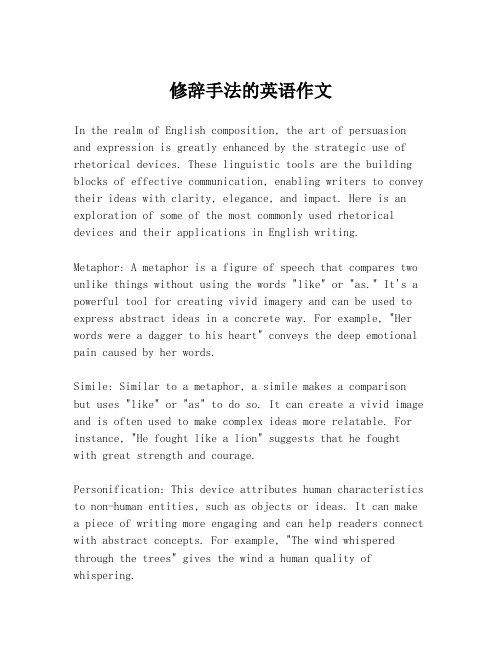
修辞手法的英语作文In the realm of English composition, the art of persuasion and expression is greatly enhanced by the strategic use of rhetorical devices. These linguistic tools are the building blocks of effective communication, enabling writers to convey their ideas with clarity, elegance, and impact. Here is an exploration of some of the most commonly used rhetorical devices and their applications in English writing.Metaphor: A metaphor is a figure of speech that compares two unlike things without using the words "like" or "as." It's a powerful tool for creating vivid imagery and can be used to express abstract ideas in a concrete way. For example, "Her words were a dagger to his heart" conveys the deep emotional pain caused by her words.Simile: Similar to a metaphor, a simile makes a comparison but uses "like" or "as" to do so. It can create a vivid image and is often used to make complex ideas more relatable. For instance, "He fought like a lion" suggests that he fought with great strength and courage.Personification: This device attributes human characteristics to non-human entities, such as objects or ideas. It can make a piece of writing more engaging and can help readers connect with abstract concepts. For example, "The wind whispered through the trees" gives the wind a human quality of whispering.Hyperbole: An exaggeration used for emphasis or effect, hyperbole can make a statement more memorable and impactful. It's often used in humor or to make a point more forcefully. For example, "I've told you a million times" is a hyperbole that means the speaker has told the listener many times.Alliteration: The repetition of the same initial consonant sound in consecutive or closely connected words can create a musical quality in writing. It can be used for emphasis or to create a memorable phrase. For example, "Peter Piper picked a peck of pickled peppers" is a well-known alliterative phrase.Anaphora: The repetition of a word or phrase at the beginning of successive clauses or sentences is known as anaphora. It can create a rhythmic effect and can be used to emphasize a point. For example, "We will fight for our freedom, we will stand for our rights, we will never give up."Antithesis: This is the juxtaposition of contrasting ideas within a parallel grammatical structure. It can be used to highlight the contrast between two concepts. For example, "To be or not to be, that is the question" presents a stark contrast between existence and non-existence.Paradox: A statement that despite sounding reasonable leads to a conclusion that seems senselessly or logically unacceptable. Paradoxes can provoke thought and stimulate discussion. For example, "The more I want to forget, the more I remember" is a paradox that captures the irony of memory.Oxymoron: A figure of speech in which two words expressing contradictory ideas are combined. Oxymorons can be used to highlight the complexity of a situation or to add humor. For example, "deafening silence" combines two contradictory concepts to describe a silence that is so profound it feels loud.By understanding and incorporating these rhetorical devices into their writing, students can elevate their compositions to a higher level of sophistication and persuasive power. Whether aiming to inform, persuade, or entertain, the use of rhetorical devices can greatly enhance the effectiveness of any piece of writing.。
修辞手段英语作文

修辞手段英语作文In the art of writing, English composition is not just about stringing words together; it's about crafting a piece that resonates with readers. One of the most powerful tools in a writer's arsenal is the use of rhetorical devices. These are techniques that can enhance the persuasiveness, clarity, and impact of written work.1. Metaphor: A metaphor is a figure of speech that makes a comparison between two seemingly unrelated things. It can make abstract concepts more tangible and vivid. For example, "Time is a thief," instantly paints a picture of time as a stealthy entity stealing away our moments.2. Simile: Similar to a metaphor, a simile makes a comparison but uses "like" or "as" to do so. It can be a more explicit way to draw parallels. For instance, "Her smile was as warm as the sun," directly compares the warmth of a smile to the warmth of the sun.3. Personification: This device attributes human characteristics to non-human entities. It can bring inanimate objects or abstract ideas to life. "The wind whispered through the trees," gives the wind a human quality of whispering.4. Hyperbole: An intentional exaggeration used to make a point more dramatic or to emphasize a feeling or situation."I've told you a million times," is a hyperbole that emphasizes the speaker's frustration.5. Alliteration: The repetition of the same initial consonant sound in neighboring words or phrases. It can make language more memorable and rhythmic. "Peter Piper picked a peck of pickled peppers," is a classic example of alliteration.6. Anaphora: The repetition of a word or phrase at the beginning of successive clauses. It can create a strong sense of rhythm and emphasis. "We will fight on the beaches, wewill fight on the landing grounds, we will fight in thefields and in the streets," is a famous use of anaphora by Winston Churchill.7. Antithesis: The juxtaposition of contrasting ideas withina parallel grammatical structure. It can highlight the contrast between two concepts. "Not in a hurry, but not too slow," presents two opposing ideas in a balanced way.8. Paradox: A statement that despite sounding reasonable leads to a conclusion that seems senselessly or logically unacceptable. "The more I want to forget, the more I remember," is a paradox that captures the irony of memory.9. Irony: Expressing one's meaning by using language that normally signifies the opposite, typically for humorous or emphatic effect. "What a beautiful day to save the world," said as the sky is falling, is an example of irony.10. Apostrophe: A figure of speech in which a writer directlyaddresses an absent person, an abstraction, or a nonhuman entity. "Oh, Time, how quickly you fly," is an apostrophe that addresses time as if it could hear.Incorporating these rhetorical devices into your English composition can elevate your writing from ordinary to extraordinary. They can help you paint a picture with words, persuade your audience, and leave a lasting impression. Remember, the key to effective use of rhetorical devices is moderation and relevance; overuse can make your writing seem contrived, while irrelevant use can confuse your readers.。
- 1、下载文档前请自行甄别文档内容的完整性,平台不提供额外的编辑、内容补充、找答案等附加服务。
- 2、"仅部分预览"的文档,不可在线预览部分如存在完整性等问题,可反馈申请退款(可完整预览的文档不适用该条件!)。
- 3、如文档侵犯您的权益,请联系客服反馈,我们会尽快为您处理(人工客服工作时间:9:00-18:30)。
二、各种词语的修辞作用(一)古词语(Archaic)“On my life,” said Quentin, “Y ou are under some delusion——I know nothing of Saint Paul.”“Nay, we question you not,” said the burgher: “although hark ye——I say, hark in your ear——my name is Pavilion.“And what is my business with that, Seignior Pavilion?” said Quentin.“Nay, nothing——only methinks might satisfy you that I am trustworthy.”(“说句天地良心的话,”奎廷说,“你是有些误会——我根本不熟悉圣.保罗。
”“不,我们没有询问你,”那个市民说:“你听着,喂,你用耳朵听着——我的名字是巴维伦”。
“可是那与我有什么相干?巴维伦先生。
”奎廷说。
“不,不相干——只是我想它应该可以使你满足了,我是可以信赖的。
”)“Prithee, do me so much favour, as to inquire after my astrologer, Martinus Galeotti, and send him hither to presently.”“I will, without fail, my liege,” answered the jester,” and I wot well I shall find him at Dopplethur‟s.”(“请你给我帮个忙,问候一下我的占星家马替勒斯.加里奥梯,同时叫他马上到我这儿来。
”“皇上,一定做到,”小丑回答道,“我知道我在多波舍家一定能找到他。
”)I do verily believe I could count on the exceptions on the fingers of my two hands.(我确实相信,我可以掐着两只手的指头算出这些例外。
Departing from us, Comrade Lenin enjoined us to guard and strengthen the dictatorship of the proletariat. We vow to you, Comrade Lenin, that we shall spare no effort to fulfill this behest, too, with honor!(列宁同志和我们永别时嘱咐我们要保卫并巩固无产阶级专政。
列宁同志,我们谨向您宣誓:我们也一定不遗余力来光荣地执行您的这个遗嘱!)(二)书面文学词语(Literary words)This is the part of the edifice of society that society chooses to ignore.Society opened its portals to me.I had been in the cellar of society, and I did not like the place as a habitation.Then we‟ll cleanse the cellar and build a new habitation for mankind…(这是社会大厦的一部分,它是社会愿意忽视的那一部分。
社会向我打开着它的大门。
我曾经在社会的底层呆过,我不喜欢那个地方作为住所。
因此我们要把这个底层打扫得干干净净,为人类建设一个新的住所……)Edifice(大厦),portal(洞门),habitation(住所)都是书面文学词语,作者通过这些词造成一种严肃、隆重的气氛。
(三)外来词(Foreign words)“Why don't you like those cousins, Father?” Soames lifted the corner of his lip.“What made you t hink of that?”“Cela se voit.”“…That sees itself!‟ what a way of putting it!”(“您为什么不喜欢那些表兄弟?父亲。
”索姆斯翘起他的嘴角。
“什么事使你想起这个来啦?”“事情本身明摆着。
”(“事情本身明摆着!讲得多好呵!”)(四)口语词(Colloquialism)…Any how, old chap. I owe to you that I’m here, I should have been in the big dark by now. No more bed. Or baccy; no more anything. (……不管怎么说,老朋友,我现在还能在这儿,全靠你;要不然,我现在早葬身黑暗的大海里了。
不再会有床,不再会有烟草,什么也不会有。
)这里chap、baccy和I‟m都是口语词。
“Hh‟m! I think that‟s rather gloomy. I say, I hope my young sisters have been decent to you?”“A wfully decent”.(“嗯,我看这有点儿凄惨”。
我说,“我希望我的几个妹妹对你都挺好。
”“太好啦!”)decent本是一个没有什么修辞色彩的词,它的原义是:正派的、庄重的。
但进入口语后,词义上起了特殊的变化,在它们原有的含义上增加了所谓情感的内容,表示“相当好”。
(五)行话(Jargon)行话是各个行业自己运用的一种特别用语。
它们主要用于相关的职业内的人物语言中。
行话的修辞作用在于活跃职业性的话题,去掉不必要的沉闷的气氛。
例如:“What is trig?”“Trigonometry,” Norman said, “A higher form of math.”“And what is math?” was the next question, which, somehow, brought the laugh on Norman.(“trig是什么呀?”“trig是一门高等的math,”诺曼答道。
说话人接着又问:“那math是什么呢?”这句话不知怎么的叫诺曼笑了起来。
)trig,math这些缩写词都是学生最爱使用的行话。
(六)俚语(Slang)。
例如:The Forsyte Saga(《福尔赛世家》)中的蒙泰克最喜欢用ripping,corking,some等俚语代替good和excellent。
The young man, who had been turning his head from side to side, became transfixed. “I say!”He said, “…some‟picture!”(这个不断地把头转过来转过去的年轻人,惊呆住了。
“喂,”他说:“图画真漂亮!”)“His name was Swithin!”“What a corking name!”(“他的名字叫斯维辛。
”)“多么好听的一个名字!”)“What is Sawbones?” inquired Mr. Pickwick, not quite certain whether it was a live animal or something to eat.“What, don‟t you know what a Sawbones i s, sir?” inquired Mr. Weller. “I thought everybody know‟d as Sawbones was a surgeon.”(七)俗语(Vulgarism)Higgins: …Angrily)By the way: my dressing gown smells most damnably of benzene.(希金斯:……(生气地)说起来才想到:我的晨衣有汽油的气味,他妈的真臭。
)(八)术语(T echnical terms)例如杰克.伦敦在其Martin Eden(《马丁.伊登》)中,使用了许多航海用语。
例如:I am like a navigator on a strange sea without chart or compass. Now I want to get my bearings. Maybe you can put me right.(我像一个没有海图没有罗盘航行在陌生的海域里的驾驶员。
现在我要知道我的方位。
或许你能给我校正。
)Navigator(驾驶员),chart(海图),compass(罗盘),bearings(方位)都是航海的术语。
在这里极其形象地描绘了主人公流落、漂泊的生涯。
“She won‟t know, and he won‟t know, and nothing must be said, of course. It‟s only for five days, V al.”“Stable secret! Right——o!”(“她不会知道, 他也不会知道,而且什么也不应当讲,当然。
只用五天,瓦尔!”“马棚的秘密!行!”)这里用于与赛马和养马有关的术语,表示贝拉.达尔梯熟悉赛马。
(九)方言(Dialect)“I‟d like Central Aus try lia. We had a book in there about it. …I‟d like some sun. I believe if we’ad sun we‟d both be twice the size we are…”“How much does it cost to get out there?”“A lot more than we can ly hands on,that is the trouble. But I‟ve been thin kin’…”这里Australia在伦敦方言里变成了Austrylia;we had变成了we‟ad;lay变成了1y;thinking变成了thinkin‟。
(十)应变词(Coined terms)例如按照humanity(人性)的构词法类推,可以构成新词womanity(女性)作为womankind或womanhood (女性)的一种戏谑的同义词。
这种应变词在有些文学家的笔下生花,常可达到滑稽的效果或造成生动的形象;有时甚至妙不可言。
